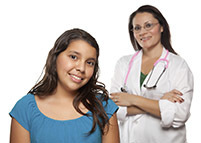 Driving Safety Resources, New Youth Risk Behavior Information, Supporting Young Males' Health, and MoreJune 2014 |  New Statistics on Teen Risk BehaviorsThe latest results from CDC's Youth Risk Behavior Surveillance System (YRBSS) provides updated information on the risk behaviors of U.S. high school students. This year's YRBSS shows declines in some risky behaviors including drinking alcohol, getting in a fight, and using drugs. This year's report is also the first to include trend data on electronic bullying and shows a slight decrease in this behavior among high school students since 2011. It also features new questions on texting or e-mailing while driving, sleep, and sun safety. |
 Promoting Food LiteracyThe U.S. Food and Drug Administration developed "Read the Label," the next phase of its Spot the Block nutrition label reading campaign. This hands-on tool unites youth, family, and community outreach leaders around the goal of making smart and healthy food choices. The Read the Label Youth Outreach Campaign targets young adolescents and educates them on how to find and read nutrition labels. It also includes tips and videos to help youth compare the nutritional value of different foods. |
 Educating Youth in Foster CareAbout 400,000 children and youth are in the foster care system at any given time. According to the U.S. Department of Education, youth in foster care are at a high risk of dropping out of school. They have released new guidance and materials on how educators in school settings can support youth in foster care. |
 Meeting Adolescent Health Needs through MedicaidState Medicaid programs are pioneering innovative strategies for reaching adolescents, both to increase the rate of adolescent well-care visits and to strengthen the provider-adolescent relationship. In the archived webinar "Engaging Adolescents through the Medicaid Benefit for Children and Adolescents," the Centers for Medicare & Medicaid Services present opportunities and promising strategies for states to leverage the Medicaid benefit for children and youth. The webinar also shared a new comprehensive adolescent health screening Maintenance of Certification (MOC) Part IV activity approved by the American Board of Family Medicine and the American Board of Pediatrics. It is intended to help primary care physicians improve the delivery of care to adolescent patients. |
Promoting the Health of Young Men of ColorA group of 11 foundations announced a new action plan to maximize the potential of the private sector to improve life and health outcomes for young men of color. The plan includes investments and initiatives in communities, schools, and the juvenile justice system that will develop positive messages about young men of color and promote leadership development. | |  |
 Community Action to Prevent Youth ViolenceEvery day 13 young people are killed and 1,600 are treated in emergency departments for non-fatal injuries in the United States. CDC's National Center for Injury Prevention and Control released "Preventing Youth Violence: Opportunities for Action" and its companion guide as two resources that can address these statistics. These materials offer evidence-based action steps that everyone in a community can take to decrease youth violence. |
| | |

| This email was sent to iammejtm@gmail.com using GovDelivery, on behalf of the U.S. Dept. of Health & Human Services · 200 Independence Avenue SW · Washington DC 20201 · 1-877-696-6775 |  | |









No comments:
Post a Comment